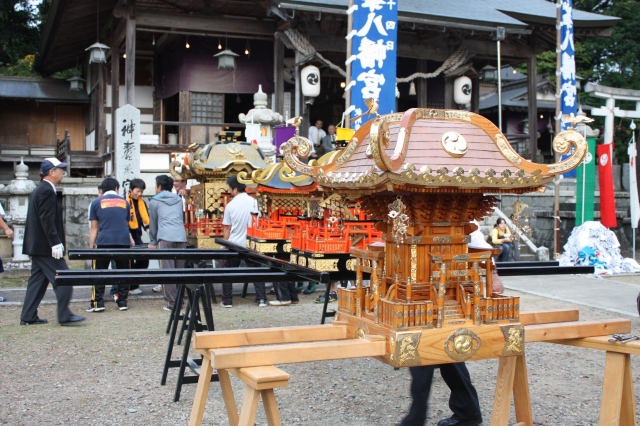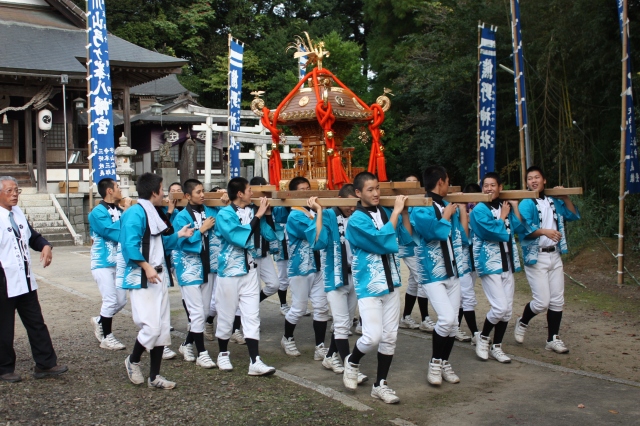Mikoshi are often referred to as “portable shrines”. They are structures built in the image of a shrine and are believed to house a Shinto god (kami). During festivals they are carried on the shoulders of local townspeople and paraded throughout the neighbourhoods that worship at the shrine they are permanantly housed at.
This past weekend was Kawamoto’s mikoshi festival. The weather was perfect – warm and cloudy with the fall colors just beginning to spread across the mountainsides surrounding town. A large group of participants gathered at the main shrine, organizing into mikoshi-carrying teams and getting dressed for the event.
In Kawamoto, the main shrine is built halfway up a steep hill, making the first descent of the mikoshi a difficult one.
There are several styles of carrying the mikoshi – two of which I experienced at Kawamoto’s mikoshi festival:
Hira-Katsugi is the “normal style” – in which the bearers chant “wa syoi” in unison while carrying the mikoshi.
In Edomae-style, the bearers sway the mikoshi from side to side and raise and lower it rapidly, with the idea that the kami is being entertained by this boisterious activity. The local high school baseball team participated most enthusiastically in this style of carrying the mikoshi, which I found to be more dangerous than entertaining…
All bearers wore traditional Japanese garb – including hapi (jacket), obi (belt), tabi (camel-toe shoes) and hachi-maki (headband).

 We carried the mikoshi along a set route through Kawamoto, stopping several times to rest our shoulders and drink the complimentary beer that was being handed out to all participants. Most of the townspeople came out to watch the parade – bowing and clapping their hands when the mikoshi passed. Two women were going from house to house with a large bottle of nihonshu and a tray of small dishes – given small amounts of the Japanese alcohol to elderly on-lookers.
We carried the mikoshi along a set route through Kawamoto, stopping several times to rest our shoulders and drink the complimentary beer that was being handed out to all participants. Most of the townspeople came out to watch the parade – bowing and clapping their hands when the mikoshi passed. Two women were going from house to house with a large bottle of nihonshu and a tray of small dishes – given small amounts of the Japanese alcohol to elderly on-lookers.
The group I carried the mikoshi with was comprised entirely of women. Our leader carried a fan and a whistle, which she used to direct us and time our chanting.
Upon returning the mikoshi to the main shrine all participants were treated to a mid-afternoon meal of miso soup, akaten, chikuwa and beer, beer, beer.
 There were a total of four mikoshi carried during this festival. The largest had not been carried in twenty-six years.
There were a total of four mikoshi carried during this festival. The largest had not been carried in twenty-six years.
 It was a delightful afternoon.
It was a delightful afternoon.
I was once again struck by how incredibly friendly the people I meet here are. It is difficult to find ways to match their kindness – I always feel as though I am not appreciative enough as my friends and coworkers go out of their way to ensure my well-being. I hope I’m not fooling myself by thinking that my enthusiastic participation is reward enough for their efforts.





